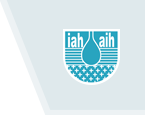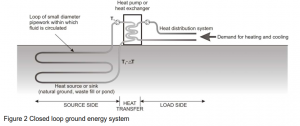Earlier Events
Past Events in Christchurch
23 July 2019
Technical meeting presented by Mr Matt Dodson from Environment Canterbury. This event was kindly sponsored by Environment Canterbury who provided the venue and the drinks for the event.
“Development of a conceptual model for recharge through loess soils”
A copy of the abstract can be downloaded here:
13 September 2017
Technical meeting presented by Mr Matt Dodson and Mr Zeb Etheridge from Environment Canterbury. This event was kindly sponsored by Aqualinc who provided the venue and the drinks for the event.
Collaborate until it hurts: development of a conceptual and numerical groundwater model for the Waimakariri CWMS zone
Abstract
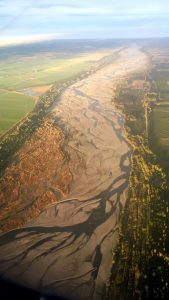 The pressure on Canterbury’s water resource has increased significantly over the last two decades, which lead to a highly adversarial approach to allocation and management, infrastructure provision, and related land management practices, leading to sub-optimal outcomes. The Canterbury Water Management Strategy (CWMS) strategic framework recognised that it was not in the best interests of anyone in Canterbury for that situation to continue, and identified a better way forward, based on collaboration and integrated management. The CWMS framework has now been operating since 2009, which is now being adopted and adapted in other parts of New Zealand.
The pressure on Canterbury’s water resource has increased significantly over the last two decades, which lead to a highly adversarial approach to allocation and management, infrastructure provision, and related land management practices, leading to sub-optimal outcomes. The Canterbury Water Management Strategy (CWMS) strategic framework recognised that it was not in the best interests of anyone in Canterbury for that situation to continue, and identified a better way forward, based on collaboration and integrated management. The CWMS framework has now been operating since 2009, which is now being adopted and adapted in other parts of New Zealand.
The core elements of the collaborative process from a science perspective are providing digestible information to Zone Committees and local communities to support resource management decision making, and working with partners, stakeholders and their trusted advisors to develop a broadly agreed scientific understanding of the hydrological system. In order to improve our understanding of the groundwater system and provide a tool for assessment of “what if” resource management scenarios, Environment Canterbury has developed a conceptual and numerical groundwater model of the Waimakariri zone in collaboration with external experts. While collaboration can be difficult and time consuming, we believe that our final outputs will be better informed and are more likely to gain “buy-in” from a wider audience. To demonstrate how we have collaborated we will highlight three examples: development of an initial conceptual model and gap analysis, use of advisory panels in model design and development, and implementation of an expert judgement excitation process to support our assessment of flow beneath the Waimakariri River.
30 June 2016
Impacts of the Darfield Earthquake on the Canterbury Aquifer System
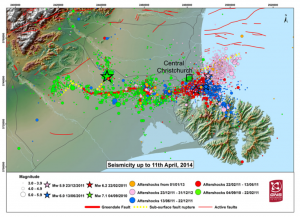 Technical meeting presented by Mrs Helen Rutter from Aqualinc. This event was kindly sponsored by Aecom who provided the venue and the drinks for the event.
Technical meeting presented by Mrs Helen Rutter from Aqualinc. This event was kindly sponsored by Aecom who provided the venue and the drinks for the event.
Abstract to be provided.
8 March 2016
Managed Aquifer Recharge Hinds Pilot
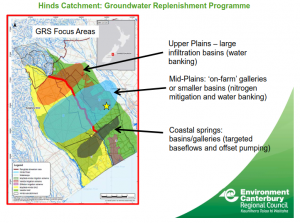 Technical meeting presented by Mr Bob Bower from Golder Associates (NZ) Ltd and Mr Patrick Durney from Environment Canterbury. This event was kindly sponsored by Golder Associates (NZ) Ltd who provided the venue and the drinks for the event.
Technical meeting presented by Mr Bob Bower from Golder Associates (NZ) Ltd and Mr Patrick Durney from Environment Canterbury. This event was kindly sponsored by Golder Associates (NZ) Ltd who provided the venue and the drinks for the event.
Please click this link to download a copy of Bob’s presentation.
Past Events in Auckland
22 November 2016
Technical meeting presented by Mr Chris Simpson from GWS Ltd. This event was kindly sponsored by Beca Ltd who provided the venue and the drinks for the event.
An Overview of the Coastal Hydrogeology of the Upper North Island, New Zealand.
Abstract
The coastal aquifers of the upper North Island can be complicated in nature and are often dominated by the localised geology and geomorphology of the area. Yet from the southern end of the Coromandel Peninsula to the Northland Region, and between the east and west coastlines, a number of commonalities exist as well as differences.
In this presentation Chris shared his experiences from having worked on coastal aquifer systems over the past 20 years on water resource, wastewater and hydrocarbon recovery projects. He provided a general description of the hydrogeologic settings at example locations, aquifer characteristics and variability between the aquifers. The presentation led on to an open discussion relating to saline intrusion mechanisms and risk to aquifers.
7 June 2016
Technical meeting presented by Mr Michael Goff from Beca Ltd. This event was kindly sponsored by Beca who provided the venue and the drinks for the event.
Successful Approaches to Managed Aquifer Recharge (MAR) – Goal Setting, Planning, Design and Execution
Abstract
The objective of this presentation is to communicate successful approaches to planning and executing a managed aquifer recharge (MAR) project. Success of a MAR project depends on establishment of appropriate goals, planning to meet those goals, careful science based design and dedication to the programme of development.
Identified goals for a project are essential in developing proper design and benchmarks for measurement of success. Goals can include disposal of unwanted water, storage of water for seasonal or long term recovery, basin replenishment and recharge for water quality benefits. These goals can be combined in many cases. A detailed understanding of the limitations of MAR and the project elements should lead to successful goal setting and project outcome.
Planning of a MAR project is more detailed in some ways than traditional surface reservoir solutions. Detailed hydrogeological and geochemical understanding is essential. Stakeholder involvement is increasingly important to successful projects especially involving reuse water.
Design considerations include availability of surplus water for recharge with regard to timing and quantity, availability of land and facilities depending on selected approach, need for treatment on recovery if applicable and establishment of monitoring for regulatory compliance and early identification of problems.
Execution of the project requires stakeholder buy-in and dedication to the programme. Monitoring must be maintained for regulatory compliance and determination of status with respect to project goals.
Technical approaches to MAR are described through the examples of actual projects in place or being developed in USA, UAE and AU. Significant cost and resource benefits of storage in aquifers over traditional surface storage approaches or development of additional resources is discussed with examples drawn from on-going projects.
22 February 2016
Technical meeting presented by Dr W Timms from University of New South Wales and IAH Vice president for Australasia and the Pacific.
Barriers to flow: advancing aquitard assessments for energy and mineral resource projects
Abstract
Aquitards, low permeability barriers to flow, can limit potential impacts of depressurization or dewatering and migration of contaminants associated with energy and mineral resource projects. Aquitard research addresses a lack of data and understanding of processes within rock strata above underground mines, and extraction of unconventional gas resources, and also within natural and engineered clayey-earth barriers to flow near open pit mines.
An overall framework for aquitard assessments was developed, including various multi-disciplinary site, laboratory and modelling studies in a staged approach commensurate with risk to the project and water resources. Detailed research within this framework will be presented including 1) reliable drill core scale measurements of vertical hydraulic conductivity (Kv), 2) approaches for core-sitebasin scale monitoring and modelling of aquitard-aquifer systems, and 3) identifying the potential of discontinuous or continuous preferential flow paths through aquitards.
Results to date include: 1) numerous Kv data for various aquitards and conditions (between 10-6 and 10-12 m/s) and benchmarking of lab methods highlighting appropriate core sampling, test fluids and conditions to prevent bias; a site example verifying lab data with in situ, high frequency pore pressure data; 2) a work flow for core-site-basin with geo-statistical methods to test representative cores (with a specified degree of heterogeneity) followed by fluvial process modelling generating multiple permeability distributions for groundwater flow modelling; and 3) innovative characterisation of a dual porosity, low permeability media by numerical modelling of a new geotechnical centrifuge test (interrupted flow); and an isotope method (vapour equilibration of δ18O, δ2H on drill core) which assists in identifying slow diffusive versus rapid transport through aquitards.
In conclusion, aquitards can effectively disconnect groundwater systems, enabling development of underlying resources. However, innovative techniques for aquitard assessment may be required where the integrity of aquitards under varying stress conditions is a potential risk to projects and water resources.
5 April 2015
Technical meeting presented by Mr Huw Williams from ENGEO, Auckland and Mr Martin Preene from Preene Consulting, Leeds, North Yorkshire, UK.
An overview of ground source energy and the importance of understanding sustainability in their design
Abstract
The use of ground energy (also referred to as shallow geothermal or ground source heat pump system) is increasingly being considered as a means to provide heating and cooling for buildings. Such systems have the potential to provide carbon emission and cost savings relative to traditional heating and cooling systems.
A ground energy system comprises three key elements:
- The load: the building, its controls and users resulting in a thermal load;
- The heat transfer system: heat pumps, heat exchangers and associated controls; and
- The source: the heat transfer system and its receiving environment, typically coupled via bores or ground loops.
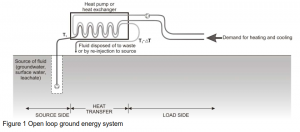 There are two types of ground energy system: open and closed loop. Open loop systems require a water source (aquifer or surface water), to abstract water for heat transfer. After use it is disposed of, at a different temperature, either to waste or by re-injection to the source.
There are two types of ground energy system: open and closed loop. Open loop systems require a water source (aquifer or surface water), to abstract water for heat transfer. After use it is disposed of, at a different temperature, either to waste or by re-injection to the source.
Closed loop systems circulate a fluid around a ground collector comprising a pipe loop. Circulated fluid passes through a heat transfer system before being recirculated through the closed loop, to exchange heat with source (soil, rock or surface water).
While the underpinning technology is not new, best practice in design is still evolving. One aspect of design requiring attention is sustainability, for which clear targets do not currently exist.
Sustainability must address short and long term considerations for the environment. However, a true assessment of sustainability requires the wider system beyond hydrogeological elements to be assessed. To determine if a ground source system can be considered sustainable, a series of tests are proposed:
- Is there suitable land and thermal resource to service the peak load?
- Can the long term thermal load be serviced?
- Will water quality affect the system or environment?
- Is the design cost effective and can operate economically?
In particular, thermal interference and water quality impacts require specialist assessment. While these tests may appear obvious to a ground source designer, they may be less obvious to others in the design team. A suitable framework for assessing sustainability should be capable of meeting the needs of designers as well as the regulators.




